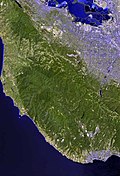Sausal Creek (San Mateo County)
| Sausal Creek | |
|---|---|
| Location | |
| Country | United States |
| State | California |
| Region | San Mateo County |
| City | Portola Valley, California |
| Physical characteristics | |
| Source | Northeast slope of the Santa Cruz Mountains |
| • location | Portola Valley |
| • coordinates | 37°22′07″N 122°13′16″W / 37.36861°N 122.22111°W[2] |
| • elevation | 683 ft (208 m)372207N 1221316W |
| Mouth | Confluence with Corte Madera Creek |
• location | Border of Portola Valley, California and Stanford University |
• coordinates | 37°23′52″N 122°14′36″W / 37.39778°N 122.24333°W[2] |
• elevation | 354 ft (108 m)[2] |
| Basin features | |
| Tributaries | |
| • left | Bozzo Gulch, Neils Gulch,[3] Bull Run Creek, Dennis Martin Creek |
Sausal Creek is a 3.0-mile-long (4.8 km)[4] northwesterly-flowing stream originating in Portola Valley along the northeastern edge of the Windy Hill Open Space Preserve in the eastern foothills of the Santa Cruz Mountains, in San Mateo County, California, United States. After being joined by Alambique Creek it flows through Middle Searsville Marsh/Pond before ending at its confluence with Corte Madera Creek in a natural marsh above Searsville Reservoir on Stanford University lands. Below Searsville Reservoir and Dam, Corte Madera Creek joins with Bear Creek to form San Francisquito Creek and flows to San Francisco Bay.
History[edit]

Historically, Sausal Creek also had the names Arroyo Sausal, Arroyo del Sanjon and Sanjon Creek.[5] On the 1899 Palo Alto Topo Map its mainstem was called Corte de Madera Creek and its Neils Gulch tributary was called Sausal Creek.[1] Sausal Creek flows through the Rancho Cañada del Corte de Madera meaning "a place where wood is cut", reflecting the importance of the timber industry in the early days of Portola Valley. "Sausal" is derived from the Spanish word "Sauce" or "Sauz" and mean "willow grove", a name that appears as early as 1853.[6]
Bozzo Gulch is named for Emmanuel Bozzo who had a ranch at the head of the canyon in the 1860s.[7]
Neils Gulch seems to have been modified from Neel Gulch, after David H. Neel, an 1850s settler.[5] It also was called Cañada de Sansevan and Hallidie Gulch.[7]
Bull Run Creek was named by a Southern sympathizer following the Union defeat at the Battle of Bull Run in the early 1860s. It has also been known as Sausal Creek, Willow Creek, Kelley Gulch, Uval Creek, Cañada de Sansevan for William Nichols Sansevain and Smith Gulch, for William R. Smith's steam-powered sawmill.[7]
Watershed[edit]
Sausal Creek heads just west of Willowbrook Drive in Portola Valley and is circled by the Spring Ridge Trail and Betsy Crowder Trail where it is dammed to form Sausal Pond. After receiving Bozzo Gulch, Niels Gulch and Bull Run Creek from the left. It runs northwest in the San Andreas Fault zone and after crossing Family Farm Road off Portola Road it is one of a nexus of half a dozen creeks that coalesce in a large natural freshwater marsh to form Corte Madera Creek. Dennis Martin Creek flows into Sausal Creek just upstream of the reservoir area at the Family Farm Road bridge. From there Sausal Creek enters Searsville Reservoir. Old maps suggest that Dennis Martin Creek and Alambique Creek were tributary to Sausal Creek.[8]
Conservation[edit]
For decades a 630 feet long section of Sausal Creek was buried in an underground culvert. In a compromise between creek preservationists and those who wanted a larger softball field, half the creek was daylighted along with construction of the new Portola Valley Town Center.[9]
See also[edit]
References[edit]
- ^ a b "Palo Alto Creeks Topo, 1899". Oakland Museum. Retrieved 2010-11-07.
- ^ a b c d "Sausal Creek". Geographic Names Information System. United States Geological Survey, United States Department of the Interior.
- ^ "Neil Gulch". Geographic Names Information System. United States Geological Survey, United States Department of the Interior.
- ^ U.S. Geological Survey. National Hydrography Dataset high-resolution flowline data. The National Map, accessed March 5, 2012
- ^ a b Alan K. Brown (1975). Place Names of San Mateo County. San Mateo, California: San Mateo County Historical Association.
- ^ Erwin G. Gudde; William Bright (2004). California Place Names: The Origin and Etymology of Current Geographical Names. University of California Press. ISBN 978-0-520-24217-3. Retrieved 2012-03-05.
- ^ a b c David L. Durham (November 2000). Durham's Place Names of the San Francisco Bay Area: Includes Marin, San Francisco, San Mateo, Contra Costa, Alameda, Solano & Santa Clara Counties. Wood Dancer Press. ISBN 978-1-884995-35-4.
- ^ Janet M. Sowers (2005). "San Francisquito Watershed and Alluvial Fan, in Creek & Watershed Map of Palo Alto & Vicinity". Oakland Museum of California. Retrieved 2011-09-18.
- ^ Sam Whiting (2008-09-13). "Fault lines in Portola Valley - Not just the San Andreas, but Sausal Creek and its ecological potential drives passions in Peninsula town". San Francisco Chronicle. Retrieved 2012-03-05.
External links[edit]
- Sausal Creek Daylighting
- San Francisquito Watershed & Alluvial Fan at Oakland Museum of California website
- San Francisquito Watershed Council
- Upper Watershed San Francisquito Creek Watershed prepared by the Oakland Museum of California
- The Creeks that Flow through Woodside by the Bear Creek League of Advocates for the Watershed (Bear CLAW)

